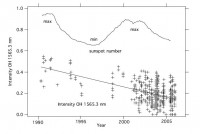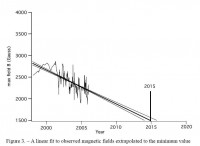By William Livingston and Matthew Penn, National Solar Observatory, Tucson, AZ
We have observed spectroscopic changes in temperature sensitive molecular lines, in the magnetic splitting of an Fe I line, and in the continuum brightness of over 1000 sunspot umbrae from 1990-2005. All three measurements show consistent trends in which the darkest parts of the sunspot umbra have become warmer (45K per year) and their magnetic field strengths have decreased (77 Gauss per year), independently of the normal 11-year sunspot cycle. A linear extrapolation of these trends suggests that few sunspots will be visible after 2015.
Sunspots are cool dark regions on the solar surface with strong magnetic fields. There have been few direct measurements of changes in the physical parameters of sunspots, but here we present a study which shows that sunspots are becoming warmer and have weaker magnetic fields. The number of sunspots visible on the Sun normally shows an 11-year periodicity, and the current sunspot cycle (cycle 23) had a maximum in 2001, and is entering a minimum phase with few sunspots currently visible. Our data show that there are additional changes occurring in sunspots, independent of the sunspot cycle, and these trends suggest that sunspots will disappear completely. Such an event would not be unprecedented, since during a famous episode from 1645-1715, known as the Maunder Minimum, the normal 11-year periodicity vanished and there were virtually no sunspots visible on the solar surface (Eddy 1976). Recent studies of the appearance rate and latitudinal drift of sunspots (Hathaway et al., 2004) and of the solar magnetic field (Svalgard etal, 2005) predict that the number of sunspots visible in future cycles will be significantly reduced. Finally the occurrence of prolonged periods with no sunspots is important to climate studies, since the Maunder Minimum was shown to correspond with the reduced average global temperatures on the Earth (Foukal et al., 1990).

The line depth of OH 1565.3 nm for individual spots. The upper trace is the smoothed sunspot number showing the past and current sunspot cycles; the OH line depth change seems to smoothly decrease independently of the sunspot cycle. See full size image here

A linear fit to observed magnetic fields extrapolated to the minimum value observed for umbral magnetic fields. See full size image here
Leif Svalgard noted on Solar Cylce 24 forum relative to this paper that “There was a tiny pore on Aug 22nd, 2008. Bill Livingston measured its magnetic field and tells me today that it was 1931 Gauss. You may verify for yourself that that falls straight on his projected line. BTW, he has many other data points now between the last data shown on the plot and this latest one, and they also confirm the trend.”
See full paper here and Astroengine.com review of it here.




